Hermagor
Author: Emmanuele Ornella
Publisher: Mind The Move / Rio Grande Games
Year: 2006
review by

| x |
|
|
|
|
|
|
|
|
|
|
|
|
|
|
|
|
|
|
|
|
|
|
|
|
|
|
|
|
|
|
|
|
|
|
|
|
|
|
|
|
|
|
|
|
|
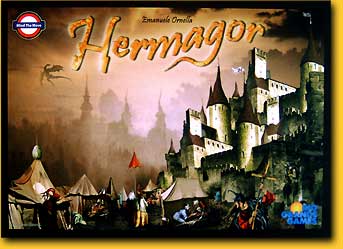 |
Once upon a time, in a kingdom far away, there was the prospering city of Hermagor. On the market of Hermagor everything was for sale, ranging from books and weapons to the more exotic skulls and dragon eggs. We players take on the role of the merchants that roam the area to find buyers for the products we buy on the weekly market of Hermagor. Of course our goal is to earn a great deal of money, but the toll roads in the surroundings of Hermagor cost us dearly, not to mention the ridiculously high prices we have to pay on the market! |
| x |
|
|
|
|
|
|
|
|
|
|
|
|
|
|
|
|
|
|
|
|
|
|
|
|
|
|
|
|
|
|
|
|
|
|
|
|
|
|
|
|
|
|
|
|
|
| The game board consists of three parts. First, there is the market, where the players can buy their merchandise. Additionally, there is a map with Hermagor in the center, connected to villages by means of toll roads. In each village the type of goods that can be sold by the players is depicted. Lastly, there is a price list showing the curent market value of the goods. |
| x |
|
|
|
|
|
|
|
|
|
|
|
|
|
|
|
|
|
|
|
|
|
|
|
|
|
|
|
|
|
|
|
|
|
|
|
|
|
|
|
|
|
|
|
|
|
| The game plays in four or five rounds, depending on the number of players. Each round, a tile is drawn that shows how many actions the players have in this turn: 3, 4 or 5. Next, the players are going to the market, that consists of 20 booths in a grid. On each booth, a tile is placed that is draw randomly from a bag. Most tiles depict one or two of the eight different goods. Some tiles allow special actions. In turn order, the players place a merchant in their colour on a booth, or on a circle in one of the alleys surrounding the booths. Placing a merchant on a booth costs 2 gold, and placing a merchant in an alleys costs the amount depicted in the circle (2 to 5 gold). |
|
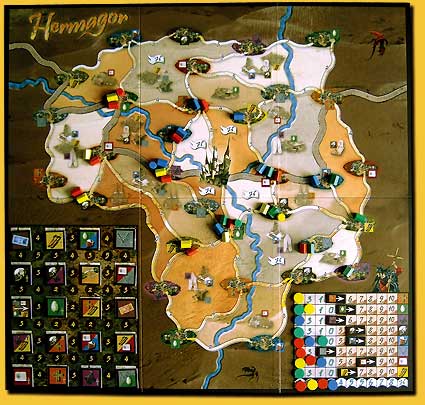 |
| x |
|
|
|
|
|
|
|
|
|
|
|
|
|
|
|
|
|
|
|
|
|
|
|
|
|
|
|
|
|
|
|
|
|
|
|
|
|
|
|
|
|
|
|
|
|
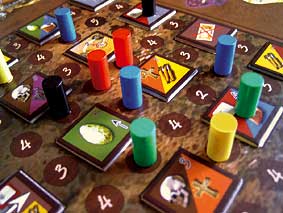 |
|
When all players have placed their four merchants, the goods are distributed. The goods tile goes to the player that has the most merchants on or adjacent to the booth. He places the tile in front of him. If there is an arrow depicted on the tile, the player is allowed to increase the market value of this specific good by one, by shifting the arrow on the price list to the right. In addition, all players receive money for the number of merchants in the same alley: players get 1, 3, 6 or 10 gold for 1, 2 3 or 4 merchants in the same alley. Merchants that are standing on a crossing count for multiple alleys. |
| x |
|
|
|
|
|
|
|
|
|
|
|
|
|
|
|
|
|
|
|
|
|
|
|
|
|
|
|
|
|
|
|
|
|
|
|
|
|
|
|
|
|
|
|
|
|
| After all the goods have been devided we set out to sell them in the surrounding villages. Each player has one merchant, that starts in the city of Hermagor. In turn order all players may move their merchant as far as they wish, as long as they pay the amounts of money depicted on the roads they use. If the player possesses a goods tile of the type of goods that can be sold in the village where his merchant ends his movement, he can sell the goods. This selling is a ‘virtual’ procedure: the player collects the current value of the goods from the bank, but he still keeps his goods tile. To indicate that he has sold goods in this village, he places a trading post. A player may never sell to the same village twice: he is not allowed to sell goods in a village that already contains one of his trading posts. |
|
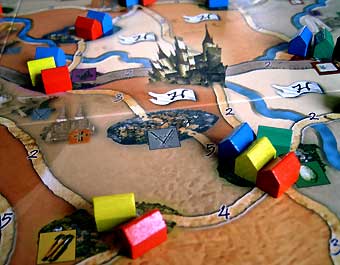 |
| x |
|
|
|
|
|
|
|
|
|
|
|
|
|
|
|
|
|
|
|
|
|
|
|
|
|
|
|
|
|
|
|
|
|
|
|
|
|
|
|
|
|
|
|
|
|
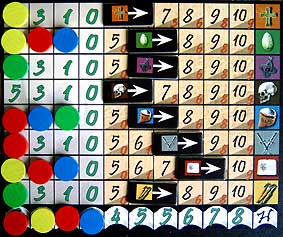 |
The map is divided into several coloured areas with some products depicted in the centre; as soon as a player has built trading posts in all the villages in one area, he may build a production building for one of the depicted goods in the area next to the price list. When placing a production building the player immediately earns a fixed amount of money, and another, variable, sum of money at the end of the game. |
| x |
|
|
|
|
|
|
|
|
|
|
|
|
|
|
|
|
|
|
|
|
|
|
|
|
|
|
|
|
|
|
|
|
|
|
|
|
|
|
|
|
|
|
|
|
|
When all players have performed their 3, 4 or 5 actions, the round is over. All goods tiles are now returned to the bag, and the market booths are refilled with randomly drawn tiles. After the fourth ( 4 or 5 players) or the fifth (2 or 3 players) round the game is over. The players receive the value of their production buildings, which depends on the current value of the goods on the price list. In addition, the player that built the most trading posts on the main road, which crosses the country from west to east, receives an additional 5 gold. The player with the least trading posts on this road has to pay a penalty of 5 gold. The map is also divided into three parts by a river; each player multiplies the number of trading posts in the area where he had the least number of trading posts by three, and adds this money to his total. The richest player wins the game!
|
|
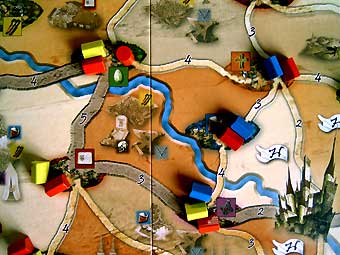 |
 |
|
|
|
|
|
|
|
|
|
|
|
|
|
|
|
|
|
|
|
|
|
|
|
|
|
|
|
|
|
|
|
|
|
|
|
|
|
|
|
|
|
|
|
|
|
| The gameboard of Hermagor is quite chaotic. Villages with products, coloured areas with other products, rivers, roads with toll prices and main roads all try to attract your attention. Fair enough, each product has its own colour, but because of the chaos on the map board this doesn’t help to make the board more transparent. That the villages have the same colour as the product that can be sold there is hardly visible, because the illustrations are too dark and the colours too subtle. |
| x |
|
|
|
|
|
|
|
|
|
|
|
|
|
|
|
|
|
|
|
|
|
|
|
|
|
|
|
|
|
|
|
|
|
|
|
|
|
|
|
|
|
|
|
|
|
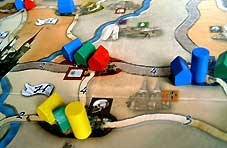 |
But enough complaining about the design. Despite the fact that Hermagor is a rather abstract game, and the atmosphere of trading in the ancient days doesn’t really come across, the game plays very well. In the first phase when players buy goods on the market place, it can get really nasty. Everybody tries to obtain as many goods tiles as possible, and to prevent that their opponents do the same. If you obtain many different product tiles, you don’t have to travel large distances in the next phase to find a village that wants to buy your goods. This really saves you some serious toll money. |
| x |
|
|
|
|
|
|
|
|
|
|
|
|
|
|
|
|
|
|
|
|
|
|
|
|
|
|
|
|
|
|
|
|
|
|
|
|
|
|
|
|
|
|
|
|
|
|
Hermagor is the type of game where you have to pay attention to many different aspects, which makes it hard to prioritise. Selling valuable goods for high income, trying to spread your trading posts evenly over the board for the end-bonus, trying to cluster your trading posts so you can build many production buildings, travel only short distances to save toll money… This results in interesting decisions to make and many different strategies to try out, all captivating enough for repeated play.
© 2006 Barbara van Vugt
Hermagor, Emmanuele Ornella, Mind The Move / Rio Grande Games, 2006 - 2 to 5 players, 12 years and up, 90 to 120 minutes
|
  |
|
|
|
|
|
|
|
|
|
|
|
|
|
|
|
|
|
|
|
|
|
|
|
|
|
|
|
|
|
|
|
|
|
|
|
|
|
|
|
|
|
  |
|
|
|
|
|
|
|
|
|
|
|
|
|
|
|
|
|
|
|
|
|
|
|
|
|
|
|
|
|
|
|
|
|
|
|
|
|
|
|
|
|
  |
|
|
|
|
|
|
|
|
|
|
|
|
|
|
|
|
|
|
|
|
|
|
|
|
|
|
|
|
|
|
|
|
|
|
|
|
|
|
|
|
|
  |
|
|
|
|
|
|
|
|
|
|
|
|
|
|
|
|
|
|
|
|
|
|
|
|
|
|
|
|
|
|
|
|
|
|
|
|
|
|
|
|
|
  |
|
|
|
|
|
|
|
|
|
|
|
|
|
|
|
|
|
|
|
|
|
|
|
|
|
|
|
|
|
|
|
|
|
|
|
|
|
|
|
|
|
  |
The most important (and exciting) phase, the market, in fact determines the further possibilities for a player in a round. |
| x |
|
|
|
|
|
|
|
|
|
|
|
|
|
|
|
|
|
|
|
|
|
|
|
|
|
|
|
|
|
|
|
|
|
|
|
|
|
|
|
|
|
|
|
|
|
Also read the  |
|
|
|
|
|
|
|
|
|
|
|
|
|
|
|
|
|
|
|
|
|
|
|
|
|
|
| x |
|
|
|
|
|
|
|
|
|
|
|
|
|
|
|
|
|
|
|
|
|
|
|
|
|
|
|
|
|
|
|
|
|
|
|
|
|
|
|
|
|
|
|
|
|
| x |
|
|
|
|
|
|
|
|
|
|
|
|
|
|
|
|
|
|
|
|
|
|
|
|
|
|
|
|
|
|
|
|
|
|
|
|
|
|
|
|
|
|
|
|
|
 |
|
|
|
|
|
|
|
|
|
|
|
|
|
|
|
|
|
|
|
|
|
|
|
|
|
|
|
|
|
|
|
|
|
|
|
|
|
|
|
|
|
 |
|
|
|
|
|
|
|
|
|
|
|
|
|
|
|
|
|
|
|
|
|
|
|
|
|
|
|
|
|
|
|
|
|
|
|
|
|
|
|
|
|
| x |
|
|
|
|
|
|
|
|
|
|
|
|
|
|
|
|
|
|
|
|
|
|
|
|
|
|
|
|
|
|
|
|
|
|
|
|
|
|
|
|
|
|
|
|
|
 |
|
|
|
|
|
|
|
|
|
|
|
|
|
|
|
|
|
|
|
|
|
|
|
|
|
|
|
|
|
|
|
|
|
 |
|
|
|
|
|
|
|
|
|
|
|
|
|
|
|
|
|
|
|
|
|
|
|
|
|
|
|
|
|
|
|
|
|
|
|